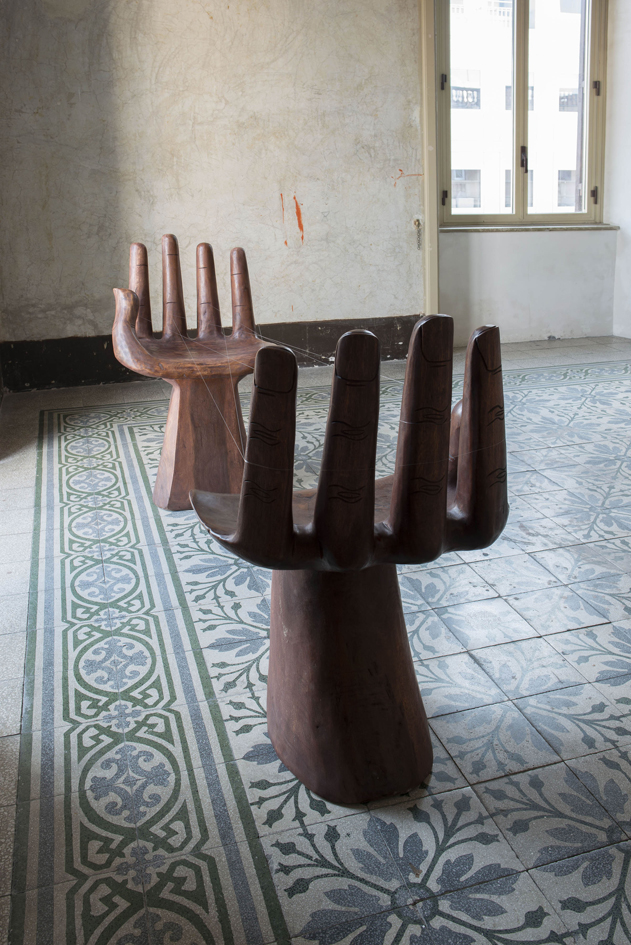Search for the origin of the work of art or on the way to Heidegger’s cabin
2005 - Drawing & Print (Drawing & Print)
30.5 x 20.5 each
Maria Bussman
The drawing “Heidegger’s Cabin” (2005) is inspired by Martin Heidegger’s essay, “The Origin of the Work of Art.” During the artist’s stay in a high alpine area, near a lake reservoir, Bussmann related the landscape in her surroundings to her reading of Heidegger’s terms on the work of art and the meaning of a “thing.” In attempt to link spiritual heights to natural heights, Bussmann metaphorically relates the subjects of being and truth to a hiking path, and its different degrees of challenge and risk. In the drawings rather than finding the optimal path to reach ultimate meaning and materialization, Bussmann never arrives at “Heidegger’s Cabin,” and instead is led off the beaten track to areas she never discovered before. Upon her return from the mountains in 2004 and 2005, she continued to develop the series, leading up to 20 drawings on handmade paper that attempt to problematize Heidegger’s theory on artworks as “things” as bearers of traits, “things” confronting the world of perception, and “things” as formed matter.
Maria Bussmann’s works represent an insistent attempt to fathom the epistemological quality of her medium, drawing. For the artist, drawing is the most direct form of artistic expression, both as a medium of analysis and of communication. Her work traditionally grows out of her relationship to reading and the generative force of philosophy and literature, as well as personal references such as temporary sites of residence. Authors that have inspired her work include philosophers Heidegger, Merleau-Ponty, Wittgenstein and Apuleius. Her drawings, at times exhibited as scrolls, exist as open-ended commentaries and annotations to philosophical thinking rather than illustrations of readings or experiences. While reading and thinking, the artist transfers visual ideas that develop in her mind into a two-dimensional space making the drawing expansive. In a transformational process, individual pictorial elements appear like encoded emblems, resulting in a rich textual interwoven fabric. The result is a bulk of sketches made into series around her interpretations of philosophical strands or subjects of reference. Maria Bussmann was born in 1966 in Würzburg (Germany). Having studied at the Academies of Fine Art in Nuremberg and Vienna, she graduated in philosophy and cultural studies from Vienna University. The artist lives and works in Vienna and New York.
Colors:
Related works sharing similar palette
» see more

© » KADIST
Tanatchai Bandasak
2019Central Region by Tanatchai Bandasak is a meditation on materiality and time-based media centres on the mysterious, prehistoric ‘standing stones’ of Hintang in Northern Laos: little-studied megaliths which have survived thousands of years of political change and the cataclysmic carpet-bombing of Laos by the United States during the Cold War...

© » KADIST
Nguyen 'Quoc' Thành
2012A Soldiers’ Garden by Nhà Sàn Collective is a night portrait series located in an army camp outside Hanoi...
Related works found in the same semantic group
» see more

© » KADIST
Adriana Lara
2014Lara uses things readily at hand to create objects and situations that interrogate the processes of art and the spectrum of roles that art and artists play in society...

© » KADIST
Mary Helena Clark
2014The Dragon is the Frame by Mary Helena Clark is an elegy that is somewhat paradoxically organized as a film noir or murder mystery, one that pays direct homage to Hitchcock’s Vertigo ...

© » KADIST
Mladen Stilinovic
1985The Exploitation of the Dead cycle is composed of a very large number of elements which the artist reorganizes differently every time...



